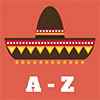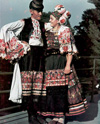Hungary
 This cute shepherd’s outerwear is rather typical for Slavic countries, especially the mountainous territories. It is called “bunda” or “suba” in Hungary; “hunia” in Ukraine; “sarică” or “bituşca” in Romania; “gunj” in Montenegro, etc. This large, heavy, and very warm sheepskin coat – or rather cloak – used to serve as clothing, a blanket, a bedcover, and a raincoat all at the same time. Today, few people in Hungary still wear it. But its unique appearance makes bunda an important part of Hungarian folk culture.
This cute shepherd’s outerwear is rather typical for Slavic countries, especially the mountainous territories. It is called “bunda” or “suba” in Hungary; “hunia” in Ukraine; “sarică” or “bituşca” in Romania; “gunj” in Montenegro, etc. This large, heavy, and very warm sheepskin coat – or rather cloak – used to serve as clothing, a blanket, a bedcover, and a raincoat all at the same time. Today, few people in Hungary still wear it. But its unique appearance makes bunda an important part of Hungarian folk culture.
- Details
- Category: Hungary
- Hits: 10977
 Slavic countries have very curious hair traditions. And this time, we’ll talk about Hungary and its folk hairstyles and headwear. The local women strictly preserved their old traditions regarding hair up to the mid-20th century. In some villages, these traditions still exist, though they’re not as widespread. In the past, say 100-200 years ago, it was a big deal as to what hairdo and headpiece a little girl, young maiden, bride, married woman with and without children, elderly woman, spinster, or widow uses. Every marital and social status needed to be showed off by the woman’s appearance and easily recognized by other people.
Slavic countries have very curious hair traditions. And this time, we’ll talk about Hungary and its folk hairstyles and headwear. The local women strictly preserved their old traditions regarding hair up to the mid-20th century. In some villages, these traditions still exist, though they’re not as widespread. In the past, say 100-200 years ago, it was a big deal as to what hairdo and headpiece a little girl, young maiden, bride, married woman with and without children, elderly woman, spinster, or widow uses. Every marital and social status needed to be showed off by the woman’s appearance and easily recognized by other people.
- Details
- Category: Hungary
- Hits: 17409
 In many cultures around the world, hair is considered sacred and an important part of human appearance and even of the local culture. The hairstyle and hair accessories often showed the status in society, age, marital status, gender, and other info about a person. For example, in Slavic countries, it was traditional for unmarried girls to braid their hair and for married women to wear it covered under coifs, bonnets, kerchiefs, etc. Practically every area in Eastern Europe has its own hairstyle traditions, customs, and superstitions. Let’s look at the ones typical for unmarried females in Hungary.
In many cultures around the world, hair is considered sacred and an important part of human appearance and even of the local culture. The hairstyle and hair accessories often showed the status in society, age, marital status, gender, and other info about a person. For example, in Slavic countries, it was traditional for unmarried girls to braid their hair and for married women to wear it covered under coifs, bonnets, kerchiefs, etc. Practically every area in Eastern Europe has its own hairstyle traditions, customs, and superstitions. Let’s look at the ones typical for unmarried females in Hungary.
- Details
- Category: Hungary
- Hits: 8958
 The Háromszék area in Transylvania has old and rich clothing traditions. Though this region was already industrially and technically developed in the mid-19th century, the local people kept their authentic clothing styles until late in the 20th century. And one of those archaic and favored by most women garments was the traditional bodice, a cute form-fitting piece that had a whole list of advantages. Today, women still happily wear these folk bodices as a part of traditional attire during festivals, folk celebrations, and other special occasions.
The Háromszék area in Transylvania has old and rich clothing traditions. Though this region was already industrially and technically developed in the mid-19th century, the local people kept their authentic clothing styles until late in the 20th century. And one of those archaic and favored by most women garments was the traditional bodice, a cute form-fitting piece that had a whole list of advantages. Today, women still happily wear these folk bodices as a part of traditional attire during festivals, folk celebrations, and other special occasions.
- Details
- Category: Hungary
- Hits: 8025
 In Eastern Europe, there are many ethnic groups that are related to each other but have their own unique and distinctive features. And these characteristics are often seen by the slight difference in traditional outfits. This time, we’ll look closer at the folk clothing of Székely people – Hungarian ethnic group from Eastern Carpathians. Their national costumes look elegant and crisp, a cute combination of white, red, and black.
In Eastern Europe, there are many ethnic groups that are related to each other but have their own unique and distinctive features. And these characteristics are often seen by the slight difference in traditional outfits. This time, we’ll look closer at the folk clothing of Székely people – Hungarian ethnic group from Eastern Carpathians. Their national costumes look elegant and crisp, a cute combination of white, red, and black.
- Details
- Category: Hungary
- Hits: 9358
 At the beginning of the 20th century, Hungary was still a part of the Austria-Hungary or the Austro-Hungarian Empire. And only in 1918, Hungary got its independence. Here is a collection of 30 photos of graceful and sophisticated Hungarian women, caught on camera. Note the diversity of their outfits, headgear, and hairstyles. On some photos, you can also discern the delicate jewelry pieces worn by these ladies.
At the beginning of the 20th century, Hungary was still a part of the Austria-Hungary or the Austro-Hungarian Empire. And only in 1918, Hungary got its independence. Here is a collection of 30 photos of graceful and sophisticated Hungarian women, caught on camera. Note the diversity of their outfits, headgear, and hairstyles. On some photos, you can also discern the delicate jewelry pieces worn by these ladies.
- Details
- Category: Hungary
- Hits: 15492
 The Hungarian Matyó ethnic group is among the few local communities who managed to preserve and treasure its ancient-old heritage, including traditional embroidery and other clothing crafts (as well as household crafts: pottery, doll making, ornamental furniture painting, and honey gingerbread making). The Matyó embroidery is famous not only in Hungary but far outside its borders. Its designs are really rich in color and texture and require profuse imagination and skill. This ornamentation is so time-consuming that it takes months and even years to make the whole set of Matyó folk clothing.
The Hungarian Matyó ethnic group is among the few local communities who managed to preserve and treasure its ancient-old heritage, including traditional embroidery and other clothing crafts (as well as household crafts: pottery, doll making, ornamental furniture painting, and honey gingerbread making). The Matyó embroidery is famous not only in Hungary but far outside its borders. Its designs are really rich in color and texture and require profuse imagination and skill. This ornamentation is so time-consuming that it takes months and even years to make the whole set of Matyó folk clothing.
- Details
- Category: Hungary
- Hits: 16942
 The most interesting thing about the craft of embroidery around the world is that there is an endless variety of patterns, stitches, and motifs. Each country has its own features and techniques of embroidery. Hungarian traditional embroidery is usually floral and very colorful. At first glance, it looks rather simple, but take a better look – it’s the details that really matter.
The most interesting thing about the craft of embroidery around the world is that there is an endless variety of patterns, stitches, and motifs. Each country has its own features and techniques of embroidery. Hungarian traditional embroidery is usually floral and very colorful. At first glance, it looks rather simple, but take a better look – it’s the details that really matter.
- Details
- Category: Hungary
- Hits: 8250
 Traditional pieces of the male and female national costumes in Hungary: bocskor, bikla, bunda, cifraszűr, csepesz, daróc, dolman, full gatya, gatya, guba, gyűszű, hárászkendő, harisnya, kis bunda, kodmon, kuchma, kuzsók, mellrevaló, mente, pacsa, palást, párta, pendely, pille, rokolya, suba, szűr, and tüsző.
Traditional pieces of the male and female national costumes in Hungary: bocskor, bikla, bunda, cifraszűr, csepesz, daróc, dolman, full gatya, gatya, guba, gyűszű, hárászkendő, harisnya, kis bunda, kodmon, kuchma, kuzsók, mellrevaló, mente, pacsa, palást, párta, pendely, pille, rokolya, suba, szűr, and tüsző.
- Details
- Category: Hungary
- Hits: 4381
 The folk costume of Hungary is rather diverse; it differs from the other Eastern-European national dresses. The Hungarian traditional outfit has a lot of Renaissance and Baroque features. But until the beginning of the 20th century, the folk clothing of Hungary was simpler and had fewer decorations. Only in the 1930s, colorful threads were added to the patterns, and the amount of embroidery was increased. Today, Hungarian folk dress is rarely used by locals. Though, it still is unique and outstanding.
The folk costume of Hungary is rather diverse; it differs from the other Eastern-European national dresses. The Hungarian traditional outfit has a lot of Renaissance and Baroque features. But until the beginning of the 20th century, the folk clothing of Hungary was simpler and had fewer decorations. Only in the 1930s, colorful threads were added to the patterns, and the amount of embroidery was increased. Today, Hungarian folk dress is rarely used by locals. Though, it still is unique and outstanding.
- Details
- Category: Hungary
- Hits: 70360

